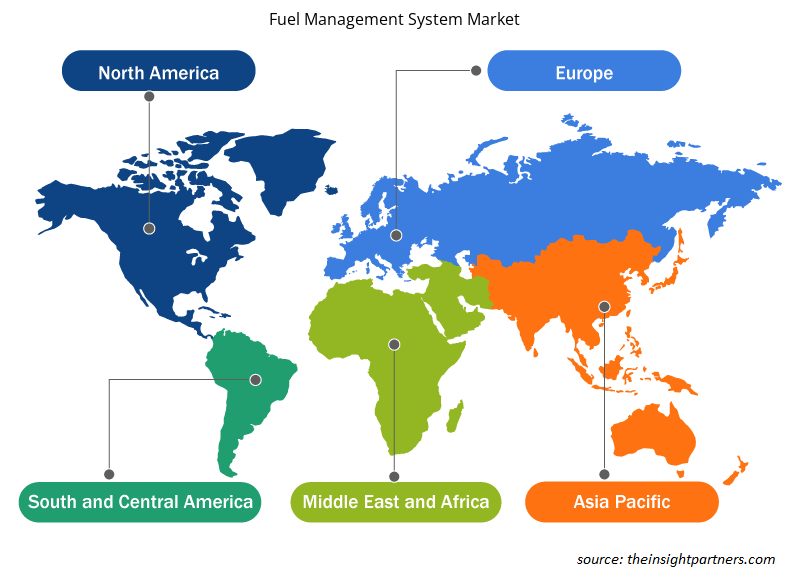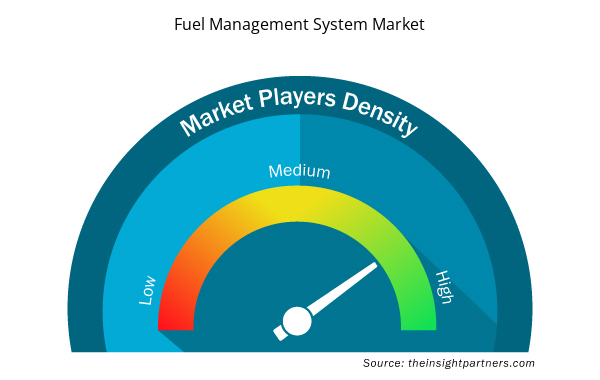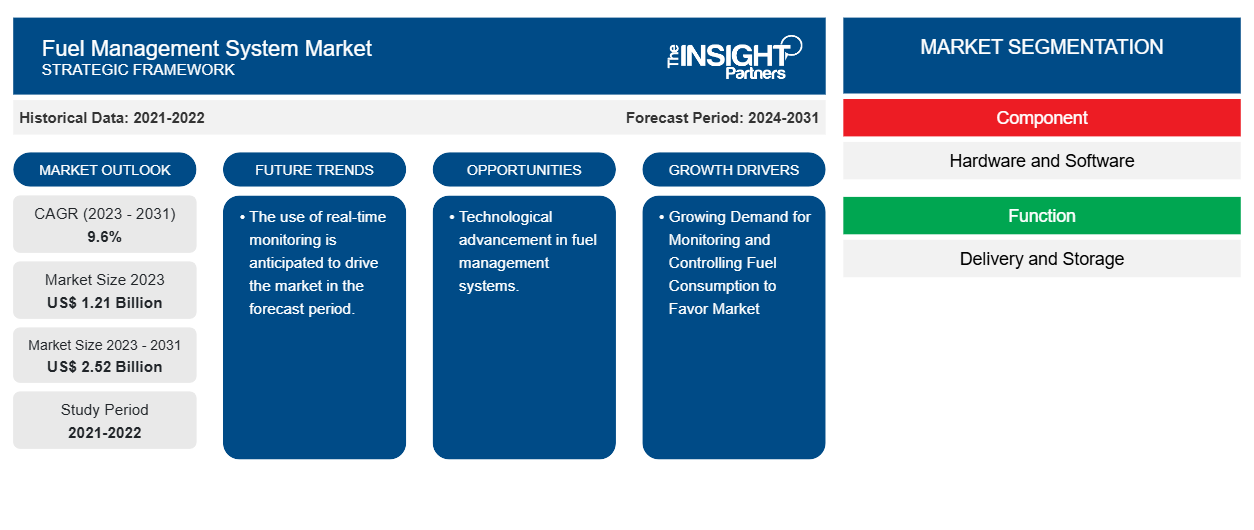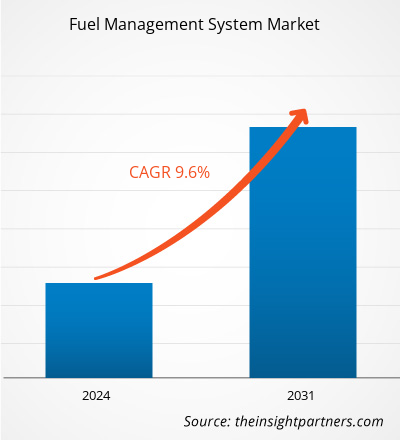Se proyecta que el tamaño del mercado de sistemas de gestión de combustible alcance los 2520 millones de dólares estadounidenses en 2031, frente a los 1210 millones de dólares estadounidenses en 2023. Se espera que el mercado registre una CAGR del 9,8 % durante el período 2023-2031. Es probable que la creciente demanda de supervisión y control del consumo de combustible y el aumento de los casos de robo de combustible sigan siendo tendencias clave en el mercado.
Análisis del mercado de sistemas de gestión de combustible
Se prevé que la demanda del mercado de sistemas de gestión de combustible aumente con la creciente necesidad de una mejor gestión del combustible para mejorar la productividad y la eficiencia en varias industrias. Además, el rápido crecimiento de las plataformas de comercio electrónico para ofrecer una mejor experiencia al cliente ha impulsado a las industrias de suministro y logística a mejorar las industrias de IoT.
Descripción general del mercado de sistemas de gestión de combustible
Un sistema de gestión de combustible es un tipo de tecnología de software y hardware que se utiliza para supervisar, controlar y optimizar el consumo de combustible en diversas aplicaciones, como en las industrias del transporte, la construcción y la energía. En los vehículos, los sistemas de gestión de combustible pueden ayudar a garantizar que el combustible se utilice de manera eficiente mediante el control del consumo de combustible, el rendimiento del motor y otros factores. Esto puede ayudar a reducir los costos de combustible, aumentar la eficiencia operativa y reducir las emisiones.
Personalice este informe según sus necesidades
Obtendrá personalización en cualquier informe, sin cargo, incluidas partes de este informe o análisis a nivel de país, paquete de datos de Excel, así como también grandes ofertas y descuentos para empresas emergentes y universidades.
- Obtenga las principales tendencias clave del mercado de este informe.Esta muestra GRATUITA incluirá análisis de datos, desde tendencias del mercado hasta estimaciones y pronósticos.
Factores impulsores y oportunidades del mercado de sistemas de gestión de combustible
Creciente demanda de monitoreo y control del consumo de combustible favorece al mercado
La creciente demanda de monitorización y control del consumo de combustible está impulsando el mercado de sistemas de gestión de combustible, ya que existen varios beneficios para la monitorización del consumo de combustible. Beneficios como ahorro de costes, identificación de ineficiencias, reducción de emisiones, etc. Además, la demanda de monitorización del consumo de combustible en tiempo real también está aumentando. Permite a las empresas identificar y abordar el desperdicio de combustible en el momento en que se produce en lugar de después del hecho. Esto puede ayudar a las empresas a reducir el consumo y los costes de combustible en tiempo real, lo que puede tener un impacto significativo en sus resultados. Teniendo en cuenta los diversos beneficios de la monitorización y el control del consumo de combustible, el sistema de gestión de combustible tiene una gran demanda.
Avance tecnológico en los sistemas de gestión de combustible.
El avance tecnológico en los sistemas de gestión de combustible ofrece varias oportunidades. Los avances tecnológicos como la integración de IoT, el análisis predictivo, los algoritmos de aprendizaje automático, la cadena de bloques para la transparencia, los vehículos energéticamente eficientes , etc. Estos avances pueden ayudar a varias industrias, incluidas la logística y el transporte, la fabricación y la cadena de suministro, la agricultura, la construcción, la gestión de flotas y los servicios, etc. Por lo tanto, el avance tecnológico en varias industrias aumenta la demanda de sistemas de gestión de combustible.IoT integration, predictive analytics, machine learning algorithms, blockchain for transparency, energy-efficient
Análisis de segmentación del informe de mercado del sistema de gestión de combustible
Los segmentos clave que contribuyeron a la derivación del análisis del mercado del sistema de gestión de combustible son el componente, la función y el usuario final.
- Según los componentes, el mercado de sistemas de gestión de combustible se divide en hardware y software. Se prevé que el segmento de software ocupe una cuota de mercado significativa en el período de pronóstico.
- Según su función, el mercado de sistemas de gestión de combustible se divide en entrega y almacenamiento. Se prevé que el segmento de entrega ocupe una cuota de mercado significativa en el período de pronóstico.
- Por usuario final, el mercado está segmentado en minería, construcción y puertos, transporte y logística, petróleo y gas, entre otros. Se prevé que el segmento minero ocupe una cuota de mercado significativa en el período de pronóstico.
Análisis de la cuota de mercado de los sistemas de gestión de combustible por geografía
El alcance geográfico del informe del mercado del sistema de gestión de combustible se divide principalmente en cinco regiones: América del Norte, Asia Pacífico, Europa, Medio Oriente y África, y América del Sur y Central.
América del Norte ha dominado el mercado de sistemas de gestión de combustible. Las tendencias de adopción de alta tecnología en varias industrias de la región de América del Norte han impulsado el crecimiento del mercado de sistemas de gestión de combustible. Se espera que factores como la mayor adopción de herramientas digitales y el alto gasto tecnológico por parte de las agencias gubernamentales impulsen el crecimiento del mercado de sistemas de gestión de combustible de América del Norte. Además, un fuerte énfasis en la investigación y el desarrollo en las economías desarrolladas de los EE. UU. y Canadá está obligando a los actores norteamericanos a traer soluciones tecnológicamente avanzadas al mercado. Además, Estados Unidos tiene muchos actores del mercado de sistemas de gestión de combustible que se han centrado cada vez más en el desarrollo de soluciones innovadoras. Todos estos factores contribuyen al crecimiento del mercado de sistemas de gestión de combustible de la región.fuelled the growth of the fuel management system market. Factors such as increased adoption of digital tools and high technological spending by government agencies are expected to drive the North American fuel management system market growth. Moreover, a strong emphasis on research and development in the developed economies of the US and Canada is forcing the North American players to bring technologically advanced solutions into the market. In addition, the US has many fuel management system market players who have been increasingly focusing on developing innovative solutions. All these factors contribute to the region's growth of the fuel management system market.
Perspectivas regionales del mercado de sistemas de gestión de combustible
Los analistas de Insight Partners explicaron en detalle las tendencias y los factores regionales que influyen en el mercado de sistemas de gestión de combustible durante el período de pronóstico. Esta sección también analiza los segmentos y la geografía del mercado de sistemas de gestión de combustible en América del Norte, Europa, Asia Pacífico, Oriente Medio y África, y América del Sur y Central.

- Obtenga datos regionales específicos para el mercado de sistemas de gestión de combustible
Alcance del informe de mercado del sistema de gestión de combustible
| Atributo del informe | Detalles |
|---|---|
| Tamaño del mercado en 2023 | 1.210 millones de dólares estadounidenses |
| Tamaño del mercado en 2031 | 2,52 mil millones de dólares estadounidenses |
| CAGR global (2023 - 2031) | 9,6% |
| Datos históricos | 2021-2022 |
| Período de pronóstico | 2024-2031 |
| Segmentos cubiertos | Por componente
|
| Regiones y países cubiertos | América del norte
|
| Líderes del mercado y perfiles de empresas clave |
|
Densidad de actores del mercado: comprensión de su impacto en la dinámica empresarial
El mercado de sistemas de gestión de combustible está creciendo rápidamente, impulsado por la creciente demanda de los usuarios finales debido a factores como la evolución de las preferencias de los consumidores, los avances tecnológicos y una mayor conciencia de los beneficios del producto. A medida que aumenta la demanda, las empresas amplían sus ofertas, innovan para satisfacer las necesidades de los consumidores y aprovechan las tendencias emergentes, lo que impulsa aún más el crecimiento del mercado.
La densidad de actores del mercado se refiere a la distribución de las empresas o firmas que operan dentro de un mercado o industria en particular. Indica cuántos competidores (actores del mercado) están presentes en un espacio de mercado determinado en relación con su tamaño o valor total de mercado.
Las principales empresas que operan en el mercado de sistemas de gestión de combustible son:
- Soluciones para flotas Chevin
- Franklin Eléctrico
- Compañía: Gilbarco Inc.
- Corporación de sistemas Multiforce.
- Navegación8
- Piusi SpA
Descargo de responsabilidad : Las empresas enumeradas anteriormente no están clasificadas en ningún orden particular.

- Obtenga una descripción general de los principales actores clave del mercado de sistemas de gestión de combustible
Noticias y desarrollos recientes del mercado de sistemas de gestión de combustible
El mercado de sistemas de gestión de combustible se evalúa mediante la recopilación de datos cualitativos y cuantitativos a partir de una investigación primaria y secundaria, que incluye publicaciones corporativas importantes, datos de asociaciones y bases de datos. A continuación, se enumeran algunos de los avances en el mercado de sistemas de gestión de combustible:
- Kongsberg Digital y Royston se asociaron para ofrecer un sistema electrónico de gestión de combustible. La asociación permitirá a los propietarios de barcos optimizar el consumo de combustible, mejorar la transparencia y promover la descarbonización de las operaciones de los buques mediante la combinación de Vessel Insight de Kongsberg Digital con Enginei, el sistema electrónico de gestión de combustible de Royston. (Fuente: Royston, sitio web de la empresa Press, febrero de 2024)
- Airbus se convirtió en socio estratégico de DG Fuels, LLC (“DGF”), un líder emergente en combustible de aviación sostenible (SAF). El sistema de producción de combustible de DGF se basa completamente en productos de desecho celulósicos, como desechos de madera de la industria maderera, y fuentes de energía renovables, como la energía eólica y solar. (Fuente: sitio web de Airbus Company, septiembre de 2023)
Informe de mercado sobre sistemas de gestión de combustible: cobertura y resultados
El informe “Tamaño y pronóstico del mercado del sistema de gestión de combustible (2021-2031)” proporciona un análisis detallado del mercado que cubre las siguientes áreas:
- Tamaño y pronóstico del mercado del sistema de gestión de combustible a nivel global, regional y nacional para todos los segmentos clave del mercado cubiertos por el alcance.
- Tendencias del mercado de sistemas de gestión de combustible, así como dinámica del mercado, como impulsores, restricciones y oportunidades clave.
- Análisis detallado de las cinco fuerzas de Porter y PEST y FODA
- Análisis del mercado del sistema de gestión de combustible que cubre las tendencias clave del mercado, el marco global y regional, los principales actores, las regulaciones y los desarrollos recientes del mercado.
- Análisis del panorama de la industria y la competencia que cubre la concentración del mercado, el análisis de mapas de calor, los actores destacados y los desarrollos recientes para el mercado de sistemas de gestión de combustible.
- Perfiles detallados de empresas.
- Análisis histórico (2 años), año base, pronóstico (7 años) con CAGR
- Análisis PEST y FODA
- Tamaño del mercado Valor/volumen: global, regional, nacional
- Industria y panorama competitivo
- Conjunto de datos de Excel


- Emergency Department Information System (EDIS) Market
- Pharmacovigilance and Drug Safety Software Market
- Medical Audiometer Devices Market
- Machine Condition Monitoring Market
- Unit Heater Market
- Human Microbiome Market
- Grant Management Software Market
- Europe Tortilla Market
- Biopharmaceutical Contract Manufacturing Market
- Cut Flowers Market

Report Coverage
Revenue forecast, Company Analysis, Industry landscape, Growth factors, and Trends

Segment Covered
This text is related
to segments covered.

Regional Scope
North America, Europe, Asia Pacific, Middle East & Africa, South & Central America

Country Scope
This text is related
to country scope.
Preguntas frecuentes
The expected CAGR of the fuel management system market is 9.6%.
The global fuel management system market is expected to reach US$ 2.52 billion by 2031.
The use of real-time monitoring is anticipated to drive the market in the forecast period.
The key players holding majority shares in the global fuel management system market are Chevin Fleet Solutions, Franklin Electric, Gilbarco Inc., Multiforce Systems Corporation., Navig8, Piusi S.p.A., OPW Fuel Management Systems Corporate, Orpak Systems Ltd., Banlaw, Syntech Systems, Inc., etc.
Increasing demand for monitoring and controlling fuel consumption and increasing cases of fuel theft are some of the factors driving the fuel management system market.
North America is anticipated to dominate the fuel management system market in 2023.
Trends and growth analysis reports related to Technology, Media and Telecommunications : READ MORE..
The Insight Partners performs research in 4 major stages: Data Collection & Secondary Research, Primary Research, Data Analysis and Data Triangulation & Final Review.
- Data Collection and Secondary Research:
As a market research and consulting firm operating from a decade, we have published and advised several client across the globe. First step for any study will start with an assessment of currently available data and insights from existing reports. Further, historical and current market information is collected from Investor Presentations, Annual Reports, SEC Filings, etc., and other information related to company’s performance and market positioning are gathered from Paid Databases (Factiva, Hoovers, and Reuters) and various other publications available in public domain.
Several associations trade associates, technical forums, institutes, societies and organization are accessed to gain technical as well as market related insights through their publications such as research papers, blogs and press releases related to the studies are referred to get cues about the market. Further, white papers, journals, magazines, and other news articles published in last 3 years are scrutinized and analyzed to understand the current market trends.
- Primary Research:
The primarily interview analysis comprise of data obtained from industry participants interview and answers to survey questions gathered by in-house primary team.
For primary research, interviews are conducted with industry experts/CEOs/Marketing Managers/VPs/Subject Matter Experts from both demand and supply side to get a 360-degree view of the market. The primary team conducts several interviews based on the complexity of the markets to understand the various market trends and dynamics which makes research more credible and precise.
A typical research interview fulfils the following functions:
- Provides first-hand information on the market size, market trends, growth trends, competitive landscape, and outlook
- Validates and strengthens in-house secondary research findings
- Develops the analysis team’s expertise and market understanding
Primary research involves email interactions and telephone interviews for each market, category, segment, and sub-segment across geographies. The participants who typically take part in such a process include, but are not limited to:
- Industry participants: VPs, business development managers, market intelligence managers and national sales managers
- Outside experts: Valuation experts, research analysts and key opinion leaders specializing in the electronics and semiconductor industry.
Below is the breakup of our primary respondents by company, designation, and region:

Once we receive the confirmation from primary research sources or primary respondents, we finalize the base year market estimation and forecast the data as per the macroeconomic and microeconomic factors assessed during data collection.
- Data Analysis:
Once data is validated through both secondary as well as primary respondents, we finalize the market estimations by hypothesis formulation and factor analysis at regional and country level.
- Macro-Economic Factor Analysis:
We analyse macroeconomic indicators such the gross domestic product (GDP), increase in the demand for goods and services across industries, technological advancement, regional economic growth, governmental policies, the influence of COVID-19, PEST analysis, and other aspects. This analysis aids in setting benchmarks for various nations/regions and approximating market splits. Additionally, the general trend of the aforementioned components aid in determining the market's development possibilities.
- Country Level Data:
Various factors that are especially aligned to the country are taken into account to determine the market size for a certain area and country, including the presence of vendors, such as headquarters and offices, the country's GDP, demand patterns, and industry growth. To comprehend the market dynamics for the nation, a number of growth variables, inhibitors, application areas, and current market trends are researched. The aforementioned elements aid in determining the country's overall market's growth potential.
- Company Profile:
The “Table of Contents” is formulated by listing and analyzing more than 25 - 30 companies operating in the market ecosystem across geographies. However, we profile only 10 companies as a standard practice in our syndicate reports. These 10 companies comprise leading, emerging, and regional players. Nonetheless, our analysis is not restricted to the 10 listed companies, we also analyze other companies present in the market to develop a holistic view and understand the prevailing trends. The “Company Profiles” section in the report covers key facts, business description, products & services, financial information, SWOT analysis, and key developments. The financial information presented is extracted from the annual reports and official documents of the publicly listed companies. Upon collecting the information for the sections of respective companies, we verify them via various primary sources and then compile the data in respective company profiles. The company level information helps us in deriving the base number as well as in forecasting the market size.
- Developing Base Number:
Aggregation of sales statistics (2020-2022) and macro-economic factor, and other secondary and primary research insights are utilized to arrive at base number and related market shares for 2022. The data gaps are identified in this step and relevant market data is analyzed, collected from paid primary interviews or databases. On finalizing the base year market size, forecasts are developed on the basis of macro-economic, industry and market growth factors and company level analysis.
- Data Triangulation and Final Review:
The market findings and base year market size calculations are validated from supply as well as demand side. Demand side validations are based on macro-economic factor analysis and benchmarks for respective regions and countries. In case of supply side validations, revenues of major companies are estimated (in case not available) based on industry benchmark, approximate number of employees, product portfolio, and primary interviews revenues are gathered. Further revenue from target product/service segment is assessed to avoid overshooting of market statistics. In case of heavy deviations between supply and demand side values, all thes steps are repeated to achieve synchronization.
We follow an iterative model, wherein we share our research findings with Subject Matter Experts (SME’s) and Key Opinion Leaders (KOLs) until consensus view of the market is not formulated – this model negates any drastic deviation in the opinions of experts. Only validated and universally acceptable research findings are quoted in our reports.
We have important check points that we use to validate our research findings – which we call – data triangulation, where we validate the information, we generate from secondary sources with primary interviews and then we re-validate with our internal data bases and Subject matter experts. This comprehensive model enables us to deliver high quality, reliable data in shortest possible time.


 Obtenga una muestra gratuita de este informe
Obtenga una muestra gratuita de este informe